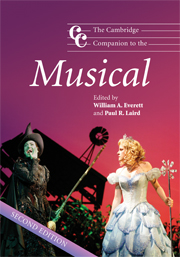Book contents
- Frontmatter
- Part I Adaptations and transformations: before 1940
- Part II Maturations and formulations: 1940–1970
- 7 ‘We said we wouldn't look back’: British musical theatre, 1935–1960
- 8 The coming of the musical play: Rodgers and Hammerstein
- 9 The successors of Rodgers and Hammerstein from the 1940s to the 1960s
- 10 Musical sophistication on Broadway: Kurt Weill and Leonard Bernstein
- Part III Evolutions and integrations: after 1970
- Part IV Legacies and transformations
- Notes
- Select bibliography
- Index
9 - The successors of Rodgers and Hammerstein from the 1940s to the 1960s
from Part II - Maturations and formulations: 1940–1970
Published online by Cambridge University Press: 28 September 2011
- Frontmatter
- Part I Adaptations and transformations: before 1940
- Part II Maturations and formulations: 1940–1970
- 7 ‘We said we wouldn't look back’: British musical theatre, 1935–1960
- 8 The coming of the musical play: Rodgers and Hammerstein
- 9 The successors of Rodgers and Hammerstein from the 1940s to the 1960s
- 10 Musical sophistication on Broadway: Kurt Weill and Leonard Bernstein
- Part III Evolutions and integrations: after 1970
- Part IV Legacies and transformations
- Notes
- Select bibliography
- Index
Summary
Musical comedies that are recognisably American in tone or theme predate the opening of Oklahoma! by many years. At the turn of the century, critics applauded the shows of George M. Cohan for the original, furiously quick-paced action and vernacular dialogue that were his trademarks. Other non-operatic popular plays of the era with appealing music began to feature more kinetic staging, homespun and believable (if often silly) characters, and an air of optimism and headstrong abandon. The singing and dancing actors of Cohan's type, masters and mistresses of the Triple Threat, bespoke a special brand of native entertainment as early as 1902. Fresh, clean, full of slangy humour and catchy songs, with plots loose enough to allow virtually any kind of specialty act to be inserted, truly American musical comedies like The Belle of New York (1897), Little Johnny Jones (1904; featuring the hit number ‘Yankee Doodle Boy’), or In Dahomey (1903; the first major African-American musical comedy to put ragtime songs on Broadway) established a type that became the standard through the 1920s.
Nevertheless, in the mid-twentieth century Oklahoma!, not merely a hit but an indisputable blockbuster of remarkable coherence, presented a new thematic direction and dramatic formula that marked yet another turning point for musical theatre and would be widely emulated. Oklahoma!'s popularity signalled a turn away from the contemporary and topical subjects preferred during the Depression Era in favour of a more sentimental style and subject. Historical subjects, especially nostalgic or patriotic American ones, could and would be portrayed on stage in a manner that avoided farce or parody. The legacy of Oklahoma! and successive hits by Rodgers and Hammerstein was multifaceted, but one of its most important elements was the book, or the story.
- Type
- Chapter
- Information
- The Cambridge Companion to the Musical , pp. 164 - 189Publisher: Cambridge University PressPrint publication year: 2008
- 1
- Cited by

